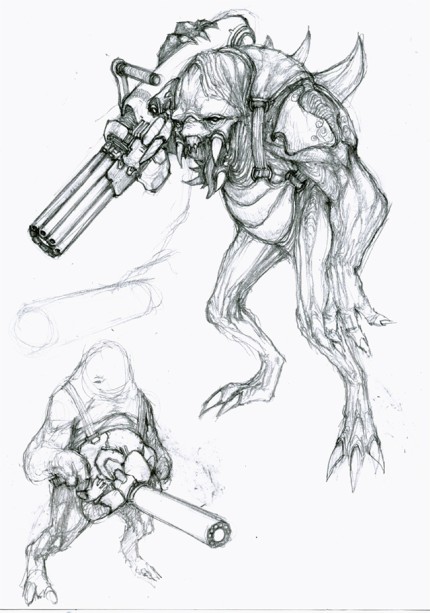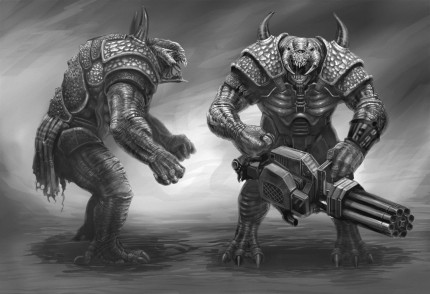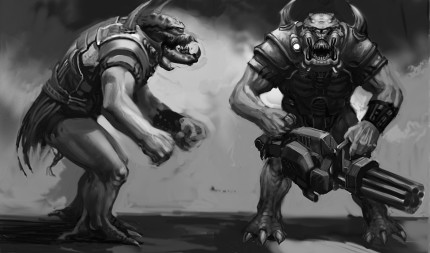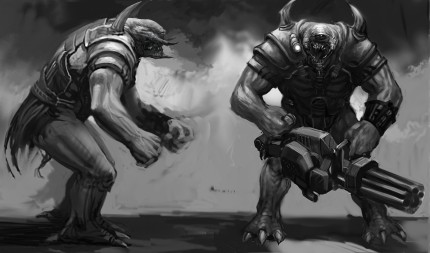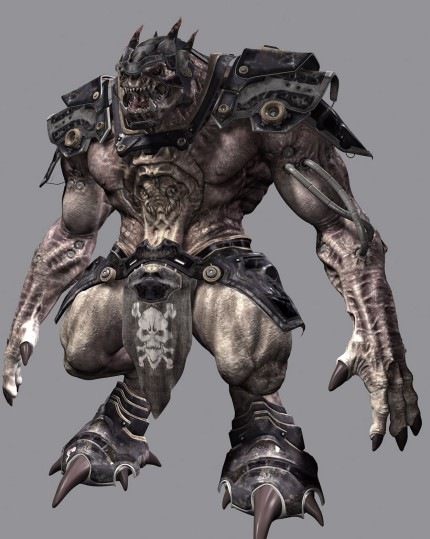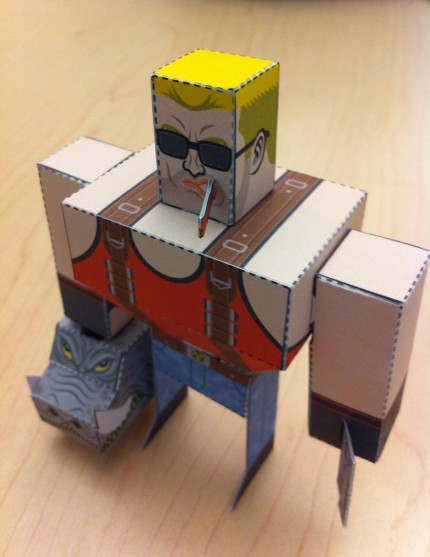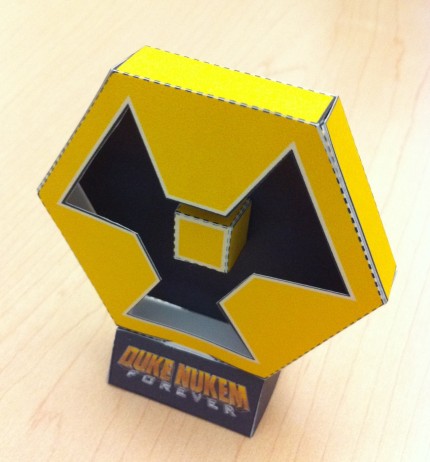PODCAST FOUR: ATMOSPHERE IN DUKE NUKEM FOREVER
April 27, 2011ELIZABETH: Welcome to the fourth episode of the Duke Nukem Forever podcast series. I’m Elizabeth Tobey, and today I’m with some of the guys from Triptych to talk about what goes in to making the atmosphere in DNF. Through art, level design, and an array of different audio tricks, these guys bring their version of Vegas to life.
ERIC: My name is Eric Von Rothkirch and I’m Audio Director at Triptych Games.
BRAD: My name is Brad Jacobs and I’m a Level Designer here at Triptych Games.
ANDREW: My name is Andrew Baker and I’m a Level Designer here at Triptych Games.
CHRIS D: My name is Chris DeSimone and I’m a CG artist at Triptych Games.
ELIZABETH: For today’s podcast we’re talking about atmosphere and location and everything that goes in to making the world of DNF believable. So let’s start with the broad and obvious. Where does Duke Nukem Forever take place and why did you choose to put it there?
CHRIS FAYLOR: The answer here is Vegas, by the way.
CHRIS D: The game Duke Nukem takes place in a variety of locations but mainly Vegas is the backdrop for the game and that’s something that was decided a long time ago, before my time; back when they first started in ’97.
ELIZABETH: More than just the where of the game, could you talk about when it takes place and sort of the liberties that you took with that “when”?
ERIC: It’s always been kind of a “near future” not really a specific time, but near future.
BRAD: I think it’s more specifically 12 years since the last game; so it’s kind of an alternate universe thing.
ANDREW: Absolutely. It takes place after Duke 3D. It is sort of a sequel. So you imagine the world of Duke 3D which is kind of an alternate United States---imagine what’s happened in 10-15 years, since then.
BRAD: Yeah.
ELIZABETH: So on a more granular level, can you talk more about some of the locations and places that you’ll see in Duke Nukem Forever and why did you decide to build out those spaces? Now I’m not just going individual levels or maps, but also indoor versus outdoor and how that really translates to the mood and also to the game play.
CHRIS D: Well, like I said before there are several different locations and mainly one of them is Vegas and of course if you’re in Vegas, you want to see a casino. And of course, in our game, Duke owns a casino so you’ll get to see what kind of a casino Duke would actually own. As well you’ll also get to see the outside and there was actually a little bit of fighting going on between what to show as far as the exterior of Vegas: should it be at night or should it be during the day? And we felt it actually looked better during the day because we could get better results from the way it looked ‘cause at night you just don’t see as much. And I know that people want to see Vegas at night, but we kind of went the other route with that. And then we also have a lot of terrain maps as well as the Hoover Dam, which of course you know is near Vegas. There’s also, I don’t know if I can say it-- there’s also kind of like an alien environment which the gamer will eventually see. I’m not going to reveal too much.
ANDREW: I know one thing I wanted to add real quick was as well as Duke’s casino, you get to see other Duke themed businesses and projects throughout the game—and I don’t want to give anything away but you go to a couple of other places that Duke may or may not be involved with his franchises and projects which were pretty interesting and cool.
CHRIS F: What I thought was interesting is that those aren’t just---well obviously the brands and franchises are made up---but the locations and even most of Vegas in the game is based on real world Vegas and then just flipped, like “what if Duke really owned Vegas?” Because he saved the world and became such a phenomenon that he could do anything he wanted.
ANDREW: I remember a funny thing was that George [Broussard] goes to Vegas or went to Vegas a lot and he brought back a whole bunch of photos from the strip that helped a lot of people. Basically he cruised the streets in his Lamborghini and took photos for a while so it gave us a good basis for a lot of locations and backdrops.
CHRIS D: Yeah that was back in ’97 or ’98 but none of us were there. Al [Blum] was. Yeah and he actually took a lot of the guys who were working at 3D Realms to Vegas and they actually stayed at a bunch of the different casinos and took reference pictures.
ELIZABETH: Yeah I’ve seen pictures of people at the Hoover Dam too.
BRAD: Speaking about Vegas streets, going back to what you were saying about daytime, a lot of games do Vegas at night and us doing Vegas during the daytime not only made it fresher, but it shows off the war a lot better, during the daytime. It’s sort of like the morning after the worst Vegas party there could possibly be; it kind of has that vibe to it and I always thought that was really fitting to Duke.
ANDREW: The alien ship showed up and turned everybody into Pig Cops.
BRAD: Yeah, that kind of thing. It’s a bad thing, yeah.
ELIZABETH: People often focus on the look of the world, in general, and you know the concept art of the big vistas; but what makes the gaming world to me are the little details, the brands that you were talking about ---the sounds, either ambient or the noises you’re actually hearing during combat. How did you guys make that realistic yet fantastical? What did you aim for and what did you focus on when making every little detail that brought the world to life?
CHRIS D: I would say that it wasn’t exactly entirely planned. I mean there were parts where like with Vegas, you kind of knew what we wanted to do and in some instances they would kind of give---I’ll just give a for instance---like a task for you to do; like another casino.
ANDREW: Yep. We approached it from both directions. We had designers that would work kind of grey box basic designs up and then artists would try and bring those to life. But we also had artist do kind of 3D concept art for us and just build the places and then we’d look at it and say, “OK well you can cut this here so I can separate these here to make this modular” and then make levels from that and they both worked.
CHRIS F: And then that 3D concept art the artists made, that wasn’t just some guy that came off the street; that was someone who actually had a background in architecture.
ANDREW: Right, one of them, Andrew Kerschner.
BRAD: Speaking to the humor and the art, like I think a lot of the humor in the game; there’s so many hidden pieces of art to find that have little jokes on them, little labels to read. There’s just jokes everywhere. I think that process really worked to the game’s favor because you had all these artists that said, “Oh I really get to put jokes in everything?” So they would just sneak in jokes whenever they could and we would just be play testing our maps and find a new piece of art and find a new joke. It was just adding value to the game, all the time.
ERIC: Speaking to some of the character and the details, what you were talking about; the mixture between real world and more over the top stuff, audio-wise, that’s always been kind of a struggle and a fun challenge. Like say you have a desert environment. Out in the desert it’s arid and windy and things like that. You don’t want it to be too realistic; you want it to be comical with little elements, like the tumble weed blowing in the background and things like that: the classics.
ANDREW: Yeah, like cliché it up, which is a good thing.
ERIC: Yeah. You almost can’t go too original with the iconic stuff. You have to bring in elements that people recognize, so we tried to do that as much as possible throughout the levels, when designing the environments.
BRAD: That’s really helped the flavor in general, I’d say.
ELIZABETH: How about casting the characters and the voices, the sounds that you hear? There’s a lot beyond just Duke’s voice that you hear that adds to the mood of the game.
ERIC: There’s a lot of dialogue in the game. You mean the NPC’s? The NPC’s we cast a lot of them at Triptych and as it turns out some of the voices were the same voices that are in Borderlands, but we didn’t know that. We did not know that; didn’t plan that.
That was just a funny coincidence, and when Randy came and looked at the game the first time, he actually recognized some of the voices and said, “Oh, I know that voice.” That was pretty funny. We went with people who could or who were willing to go over the top and were comfortable going over the top. Some people turned us down saying “This is just too goofy” and that’s fine. So we ended up finding a lot of people who had more of a silly side and wanted to do more silly stuff in their acting. That ended up working out really well for the actors that we chose.
ELIZABETH: Going a little bit into the history of the game and the long dev cycle, how did the levels change over time---either as tech change or the direction of the game changed? Is there anything that stayed pretty consistent or do you have an example of anything wildly different?
BRAD: A lot of the overall game locations and concepts stayed the same. Like the overall idea that we want this type of environment, with these types of things in it stayed the same, more or less. But yeah, like how levels were built. Several different approaches were tried.
ERIC: The general progression was the same too---not to give too much away. You started out in Duke’s casino then went out into the environment and explored those. That has all remained consistent.
ANDREW: Yeah, it’s been pretty consistent for about 5-6 years. There haven’t been any huge tech changes since then. One of my first jobs in 2005 was to take levels that were built kind of in the 2000 era with a very brush oriented mentality and convert them into more static meshes and patch mesh art. That’s what I did for the first few months I was at the office, to literally take stuff that already existed and modernize it for a while. A lot of that was cut, though. That’s one thing too; the game’s gone through multiple cuts and moments where production would literally look at the game as a whole and then start over from the perspective of what’s going to have us wind up with the best game and plan out new cuts. We would pull levels apart and put them back together; more than once. And I think that’s helped the pacing and the feel of the game immensely.
CHRIS D: Yeah, the game was definitely huge in scope. There were a lot of levels and we kind of had to just pick certain ones that we really wanted in the game and say “OK, the rest we shouldn’t do because it would take forever to make it.”
BRAD: Or really just compromise the quality of the rest of the game and this game is about customization anyways. So in order to achieve the level of customization we have in our game, you have to at some point, become very focused on those locations only. Like speaking, the game is a more linear first person shooter. It’s not like an open world type game so it’s going to be more focused.
ELIZABETH: When you talk about customization, what do you mean?
BRAD: I mean there’s so many different surprises. So many of the games these days are set in a war. Our game is set in a war, but it’s an adventure in a war and that’s not very common anymore: adventure and first person shooters have kind of fallen by the wayside. There’s probably no better universe to have an adventure in than Duke’s universe and that allowed us to do a lot of things to surprise the player. I don’t want to give anything away but I mean almost every level has something that’s going to surprise you. There’s something funny, there’s something exciting, there’s something…there’s little to know just grinding through another combat sequence in our game. It’s very much like, “Oh here’s a twist here, here’s something new that happens here, here’s a funny scripted sequence, there’s something here.”
CHRIS D: That’s what I like about it. You know, you’re not being forced through the level. You can stop and look around and like you’re saying, you can interact with things. You’re not just getting from A to B and that’s it. I mean it is a little linear, but there’s little side shoots, little areas you can explore.
BRAD: Yeah and that ties in, like you said, to the interactive side of the game. Again, I can’t give anything away, but there are so many cool, interactive things in the game and no one really does that kind of thing anymore. We have a full blown, working pinball machine in game and it works exactly like a real pinball machine. It’s not a quick and dirty mini-game. It’s a full working pinball machine. It keeps your high score, it does everything.
ANDREW: Yeah and it’s not simulated. It uses the same physics as the rest of the game. That was really hard to actually get to work and there were moments when we were like, “Why don’t we just simulate this? We can’t really do it.” But we persevered and I think that’s how a lot of the elements in the game feel: united, together because they’re all from the same thing.
I was going to go really quickly to the technical side of customization. We’ve got a few things a few technologies in the level making process that are kind of unusual, I think for game development now; in that there are a lot of tools for the level designers to customize areas with blending textures from surface to surface. We have patch mesh tools which are very much like rudimentary modeling tools in the editor. They’re kind of like the, if people will remember, patches and patch meshes from id Software’s Quake, things like Quake 3 and things like that but five years on. What would it be like? What would those tools be like? And both the artists and level designers use that together. But I think that’s why the environments feel like they do is it’s not just a series of sets of static meshes and art that you’ve seen reused and repositioned. We tried to keep things unique. If not completely unique, at least one or two things you would note as being as new like “Oh I haven’t seen this yet” as you go through the game.
ELIZABETH: Thanks for listening to this episode of the Duke Nukem Forever podcast series. We’ll be back next time to explore aliens in DNF.
BATTLELORD CONCEPTS
April 27, 2011
By now, you probably know the Battlelord very well (or his crotch, at the very least).These are some early concepts of the Battlelord as the team tried to decide the look of his head.
And while not the final render, many of you will recognize this guy from trailers we’ve released in the past!
New released screenshots
BADASS DUKE NUKEM FOREVER PAPERCRAFT
April 27, 2011
As you may know, we're including an exclusive papercraft Duke in the Balls of Steel edition. We've fielded several requests to see this figure - and today, we're unveiling what Duke will look like – right now, in fact!Now, a sneak peak of the Balls of Steel papercraft is awesome, but we're all about instant gratification, so we've made an additional DNF papercraft that you can download and make now. Check it out:

